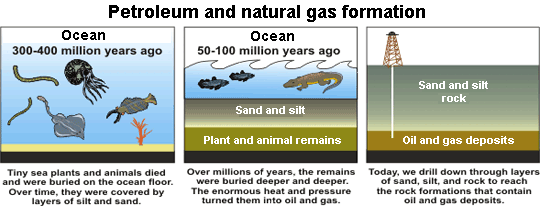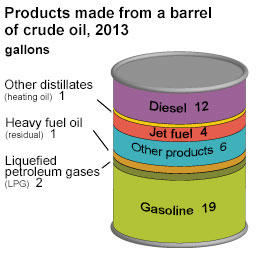How was oil formed?
Oil was formed from the remains of animals and plants (diatoms) that lived millions of years ago in a marine (water) environment before the dinosaurs. Over millions of years, the remains of these animals and plants were covered by layers of sand and silt. Heat and pressure from these layers helped the remains turn into what we today call crude oil. The word petroleum means rock oil or oil from the earth.

Products made from a barrel of crude oil
Did you know crude oil can be sweet or sour?
Crude oil is called sweet when it contains only a small amount of sulfur and sour if it contains a lot of sulfur. Crude oil is also classified by the weight of its molecules. Light crude oil flows freely like water, while heavy crude oil is thick like tar.
After crude oil is removed from the ground, it is sent to a refinery by pipeline, ship, barge, or rail. At a refinery, different parts of the crude oil are separated into useable petroleum products. Crude oil is measured in barrels.
A 42 U.S. gallon barrel of crude oil yields about 45 gallons of petroleum products. This gain from processing the crude oil is similar to what happens to popcorn, which gets bigger after it is popped.

Source: U.S. Energy Information Administration,
Petroleum Navigator, Refinery Yield, 2013 preliminary data
Note: A 42 U.S. gallon barrel of crude oil yields about 45 gallons of petroleum products.



